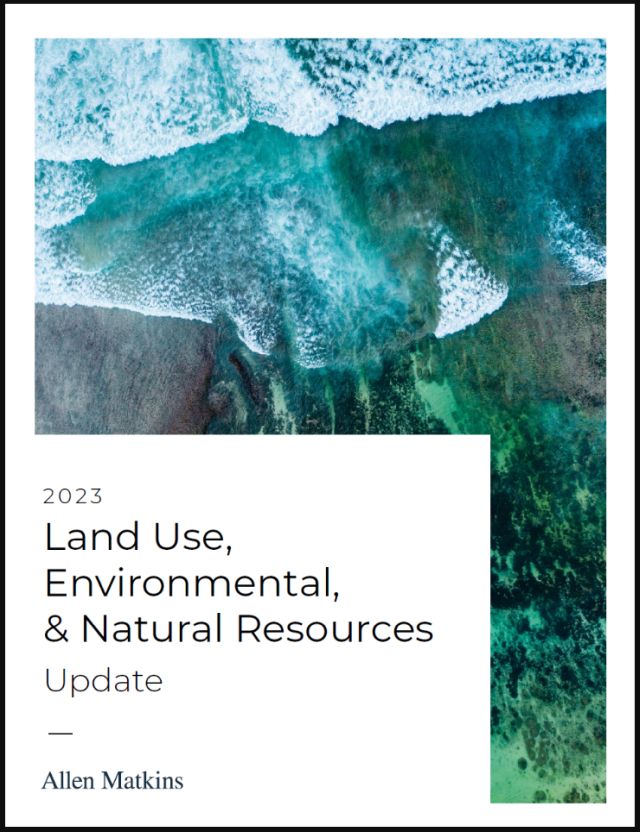There are multiple proposed bills under consideration by the State Assembly and Senate that would affect new housing developments. The following is a summary of a few of the key bills, which is current as of the date of this publication. These bills are subject to the legislative process so future amendments are expected.

SENATE BILL 423 - AMENDMENTS TO SENATE BILL 35
SB 423 (Wiener) would remove the sunset provision for and make other substantive changes to SB 35 (codified at Government Code section 65913.4). As explained in our prior legal alert, SB 35 separately provides for a streamlined ministerial approval process for qualifying housing projects in local jurisdictions that have not made sufficient progress towards their state-mandated Regional Housing Needs Allocation (RHNA), as determined by the California Department of Housing and Community Development (HCD).
SB 423 would expand SB 35 to apply when a local jurisdiction fails to adopt a housing element in substantial compliance with state housing element law, as specified and as determined by HCD. Under that circumstance, the project sponsor would need to provide a minimum of 10% low income units or, in the San Francisco Bay Area, a minimum of 20% moderate income units, as specified and before calculating any density bonus. Therefore, this change could result in the increased production of mixed-income housing since as explained in our prior legal alert, multiple local jurisdictions are currently out of compliance (and could be out of compliance in future housing element cycles).
To summarize, SB 423 would also amend SB 35 as follows:
- Remove the coastal zone development restriction.
- Remove the wetland and protected species habitat development restriction where development has been authorized by federal or other state law.
- Require projects with 50 or more housing units and using construction craft employees, as specified, to meetapprenticeship program requirements and provide health care expenditures for each employee, as specified. This would replace existing skilled and trained workforce requirements and qualifying expenditures would be credited toward compliance with prevailing wage requirements, as specified.
- Require determinations regarding compliance with applicable objective planning standards to be made by the planning director (or any equivalent local government staff).
- Prohibit local governments from requiring compliance with any standards necessary to receive a post-entitlement permit or other information (including studies) that does not pertain directly to determining whether the housing development project is consistent with applicable objective planning standards.
- Exclude the California Building Code, local building codes, fire codes, noise ordinances, other codes requiring detailed technical specifications, and studies that are evaluated with subsequent permits from the definition of objective planning standards.
- Prohibit local governments from requiring specified consultant studies or other materials that are not necessary to ascertain consistency with objective planning standards.
- Remove the planning commission (or equivalent board/commission) public oversight hearing provision (but retain the design review provision).
- Provide that the "total number of units in a development" includes: (i) all housing development projects developed on the site, regardless of when those developments occur.
- Clarify that if a local affordable housing ordinance requires units that are restricted to households with incomes higher than the SB 35 income limits, then the units that meet SB 35 income limits shall be deemed to satisfy the local requirement.
ASSEMBLY BILL 1287 - AMENDMENTS TO THE STATE DENSITY BONUS LAW
AB 1287 (Alvarez) would amend the State Density Bonus Law (Government Code section 65915) by incentivizing the construction of housing units for both the "missing middle" and for very low income households by providing for an additional density bonus and incentive/concession for projects providing moderate income units or very low income units.
First, the project must provide the requisite percentage of on-site affordable units to obtain the maximum density bonus (50%) under existing law: 15% very low income units, or 24% low income units, or 44% moderate (for sale) units. Second, to qualify for an additional density bonus (up to 100%) and an additional incentive/concession under AB 1287, the project must provide additional on-site affordable units, as specified. To illustrate, for a rental project, if the base project includes 24% low income units and 15% to 16% moderate income units, the project would qualify for a 100% density bonus and three to four incentives/concessions, respectively, under AB 1287. To illustrate, for an ownership project, if the base project includes 10% very low income units and 44% to 45% moderate income units, the project would qualify for an 88.75% density bonus and three to four incentives/concessions, respectively, under AB 1287. Under existing law, the same projects would only qualify for a 50% density bonus and three incentives/concessions.
As first introduced, AB 1287 would have amended existing law to specify that any density bonus, concessions, incentives, waivers or reductions of development standards, and parking ratios to which an applicant is entitled under the State Density Bonus Law "shall be permitted notwithstanding the California Coastal Act of 1976." This change would have limited the California Coastal Commission's atuhority over a density bonus project in the coastal zone. However, AB 1287 was amended in the State Assembly on April 26, 2023 to revert back to existing law, which provides that the State Density Bonus Law "does not supersede or in any way alter or lessen the effect or application of the California Coastal Act of 1976."
AB 440 (Wicks) would also amend provisions related to the calculation of maximum allowable residential density under the State Density Bonus Law.
ASSEMBLY BILL 1532 - "BY RIGHT" APPROVAL OF OFFICE TO RESIDENTIAL CONVERSIONS
AB 1532 (Haney) would address "the growing crisis of California's rapidly emptying downtowns and the huge need for housing statewide." It would provide for "by right" streamlined ministerial (i.e., no CEQA) approval of qualifying office to residential conversion projects. To qualify, the project must: (i) meet the definition of an office conversion project: the conversion of a building used for office purposes or a vacant office building into residential dwelling units; (ii) designate at least 10% of the on-site residential units as affordable to low or moderate income residents, as defined; and (iii) utilize a skilled and trained workforce, as specified.
AB 1532 would:
- Provide that qualifying projects shall be a use by right in all zones, regardless of the zoning of the site, and subject to ministerial review.
- Prohibit city councils, county boards of supervisors, planning commissions and other planning oversight boards from subjecting qualifying projects to "any review" and require the local planning director (or equivalent local government staff) to approve qualifying projects ministerially.
- Exempt qualifying projects from impact fees that are not directly related to the office-to-residential conversion, and allow applicants to pay any applicable impact fees over a 10-year period, with the first payment due upon the earlier of the date of final inspection or the date of issuance of the certificate of occupancy.
- Prohibit local agencies from imposing any new parking or open space requirements that were not imposed on the original office use. (See also AB 2097 regarding the elimination of parking requirements for qualifying projects.)
- Prohibit local agencies from imposing increased inclusionary housing requirements that would apply specifically because the project is approved under AB 1532.
New state funding would be available for qualifying office to residential conversion projects. AB 1532 would create the Office to Housing Conversion Fund in the State Treasury and upon appropriation, would require HCD to establish a grant program that would award funding to qualifying projects based on the project square footage.
AB 529 (Gabriel and Haney) is a related bill that would require the California Building Standards Commission to work with HCD to revise existing state adaptive reuse codes to better facilitate office to residential conversion projects. AB 529 would also allow HCD to award points to "pro-housing" jurisdictions during its housing element review process for policies that facilitate office to residential conversion projects.
ASSEMBLY BILL 1700 - CEQA: POPULATION GROWTH AND NOISE IMPACTS
AB 1700 (Hoover) would clarify that "population growth, in and of itself, resulting from a housing project and noise impacts of a housing project are not an effect on the environment" under CEQA. AB 1700 is a legislative response to the tentative ruling in a high-profile appellate CEQA ruling in which the court held that the lead agency should have analyzed those impacts in the Environmental Impact Report (EIR) for a proposed student housing project in the City of Berkeley. (Make UC a Good Neighbor v. Regents of Univ. of California, 88 Cal. App. 5th 656, (2023), as modified (Mar. 16, 2023).)
ASSEMBLY BILL 1633 - EXPANSION OF HOUSING ACCOUNTABILITY ACT PROTECTIONS: CEQA
AB 1633 (Ting) is a legislative response to a procedural loophole in the Housing Accountability Act ("HAA") (Government Code section 65589.5 et seq.), the declared intent of which is to "refine and clarify the standards" for when a local agency's failure to exercise discretion, or a local agency's abuse of discretion, under CEQA for a HAA-protected project constitutes a violation of the HAA, and to establish procedures that will allow local governments to rectify any such failure without risking HAA litigation.
There have been instances where HAA-protected projects have been stymied by a local agency's failure to approve or deny a project due to CEQA-related delays. For example, as explained in this letter from HCD to the City and County of San Francisco, the Board of Supervisors' actions to decertify and remand an EIR back to the Planning Department based on vague concerns "exemplify a pattern of lengthy processing and entitlements timeframes" that "act as a constraint on housing development."
To qualify under AB 1633, the project would need to meet the definition of a "housing development project" under the HAA and meet the following additional requirements:
- The project site is located in an urbanized area, as defined.
- The project meets or exceeds a dwelling unit density of 15 units per acre.
- The project site is not located in a coastal zone, on certain types of farmland, on wetlands, on a hazardous waste site, within a delineated earthquake fault zone, within a special flood hazard area, within a regulatory floodway, on lands identified for conservation, or on habitat for protected species, as specified.
- The project site is not located in a high or very high fire hazard zone, as specified.
Under AB 1633, the following circumstances would also constitute "disapproval" of the project, in which case the local agency could be subject to enforcement under the HAA:
- CEQA Exemptions. If (i) the housing development project qualifies for a CEQA exemption and is not subject to an exception to that exemption under the CEQA Guidelines based on substantial evidence in the record; (ii) the local agency fails to make a determination of whether the housing development project is exempt under CEQA; and (iii) the local agency does not make a lawful determination, as defined, on the exemption within 90 days of timely written notice from the applicant, as specified. The local agency may extend that time period by up to an additional 90 days if the extension is necessary to determine if there is substantial evidence in the record that the housing development project is eligible for the exemption sought by the applicant.
- Other CEQA Determinations. If (i) the housing development project qualifies for a negative declaration, addendum, EIR, or comparable environmental review document under CEQA; (ii) the local agency commits an abuse of discretion, as defined, by failing to approve the applicable CEQA document in bad faith or without substantial evidence in the record to support the legal need for further environmental study; (iii) the local agency requires further environmental study; and (iv) the local agency does not make a lawful determination, as defined, on the applicable CEQA document within 90 days of timely written notice from the applicant, as specified.
AB 1633 includes a limited exception to enforcement where a court finds that the local agency acted in good faith and had reasonable cause to disapprove the project due to the existence of a controlling question of law about the application of CEQA or the CEQA Guidelines as to which there was a substantial ground for difference of opinion at the time of the disapproval.
The content of this article is intended to provide a general guide to the subject matter. Specialist advice should be sought about your specific circumstances.



